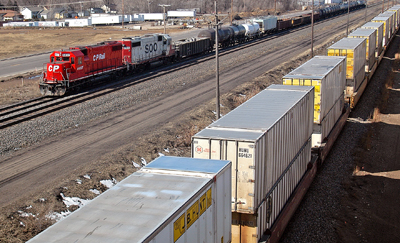By Greg Ruhland, Office of Freight and Commercial Vehicle Operations

The amount of crude oil shipped on trains is expected to double in the next 10 years as more shipments of volatile crude oil from the Bakken field in North Dakota and heavy tar sands crude from Alberta, Canada, move across the state. Photo by David Gonzalez |
MnDOT is collaborating with railroads and the Department of Public Safety to carry out new rail safety legislation signed into law July 1 by Gov. Mark Dayton.
The new law will manage the risk of spills, derailments and other dangers associated with shipping crude oil and other hazardous materials such as ethanol and anhydrous ammonia. The amount of crude oil shipped on trains is expected to double in the next 10 years as more shipments of the volatile crude oil from the Bakken field in North Dakota and heavy tar sands crude from Alberta, Canada, move across the state.
Before 2007, no crude oil was traveling by rail across Minnesota. Today, between five to seven crude trains daily pass through the state. That’s between 400,000 to 550,000 barrels of crude.
The Office of Freight and Commercial Vehicle Operations is conducting a study of highway-rail crossing improvements. The study will identify sites where safety can be improved on rail corridors that now carry trains of Bakken crude oil.
“These corridors represent about 700 miles of the 4,400 miles of railroad track in Minnesota, and are protected by approximately 690 installed crossing signals,” said Dave Christianson, senior rail planner. “These oil train routes include the BNSF main line from Seattle to Chicago, and the CP line down the west bank of the Mississippi River.”
MnDOT hired three state rail safety inspectors – one dedicated to hazardous materials – to improve freight system safety. They monitor railway alignment and conditions, as well as other structures along the tracks, such as bridges and crossings. They also review and enforce safety requirements, keep maintenance and repair records and review railroad security.
“Inspectors are a critical part of Minnesota's response to the amount of freight trains carrying oil through the state,” Christianson said.
Along with MnDOT’s increased safety inspections and emergency response training, various agencies will require updated standards for oil tank cars, emergency prevention plans by railroads, and stronger oversight of railroad companies, said Christianson.
The laws allow a three-year period for older tank cars to be modified, or “retrofitted,” into compliance. A six-year window is allowed for newer tank cars, which are much stronger and designed to prevent crude oil from igniting. Even though 15,000 to 20,000 of these newer cars have been built since 2011, this is still only a fraction of the 90,000 total cars hauling Bakken crude oil across Minnesota.
“Minnesota’s rate of rail inspections fares better than that of most states,” said Christianson, “but Minnesota can still improve its response to an ongoing risk.”
Because rail cars can travel within 60 feet of a home or business, he said rail crossing safety also remains an important consideration.
The Governor has met numerous times with local emergency managers to review the laws and discuss other ways the state can partner with communities to improve disaster preparedness.
At the federal level, the U.S. Department of Transportation issued an emergency order requiring railroads that operate trains with Bakken crude to notify State Emergency Response Commissions when operating through their states. USDOT also issued a safety advisory urging rail fleets to use tank car designs with the highest level of integrity available. A number of other proposed federal regulations are pending.
For more information, read MnDOT’s frequently asked questions. |



